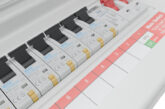
Peter Dumigan, Managing Director of the Hultafors Group UK, looks at the benefits of suiting up with the correct work clothing this winter.
When the weather takes a turn for the worse, it’s time for you to make sure you suit up with properly designed, sustainable working clothes that have got what it takes to keep you warm and dry – whatever you’re doing on-site – inside or out.
This winter, workwear choices will be as much influenced by sustainability as they are for comfort, practicality and protection. Many tradesmen and women are buying better-quality garments that will last longer because they incorporate recycled fibres in the fabric technology which reduces environmental waste.
In fact, it’s becoming more widely recognised that cheap, throwaway working clothes are contributing to our environmental concerns while garments made from sustainable ‘preferred fibres’ deliver high levels of durability and comfort. They’re good value, hard-wearing products with a long product lifetime, which is key to reducing waste.
Dressing for the weather – and the environment
If you’re freezing cold, you’re not going to be working as efficiently and comfortably as you could. That’s why wearing layers is the best way to regulate your body temperature when you’re working in unpredictable or generally inclement weather conditions. That’s why a 3-layer workwear system – base-layers, mid-layers and outer-layers will keep you warm and comfortable by transporting moisture away from your skin, insulating your body, and protecting you from cold, wet and windy weather.
Layering from head to toe
Whether it’s hot or cold, the solution to effective layering is making sure you stay dry, even when you’re working up a sweat. The best way to do just that is through the layer that’s closest to your skin – the base-layer.
Base-layers
These first-layer undergarments, including socks, are vital for staying dry and ventilated and the types you wear should ‘wick’ (transport) moisture away from your skin. The range of base-layer clothes from Snickers Workwear have seamless comfort and a great ergonomic fit, but different garments’ fabrics, such as those with ‘37.5 technology’, provide different levels of ventilation and warmth depending on how active you are while working and the weather conditions you’re working in.
For instance, during the colder months of the year, Merino wool is a natural and durable base-layer choice. While it can absorb around 5% of its own weight in moisture, this type of wool has the added benefit of being naturally odour resistant – and it’s environmentally friendly too.
Mid-layers
If your job involves moving back and forth, indoors and outside, or you find yourself constantly switching back and forth between physical and stationary tasks in colder conditions, then it’s worth paying particular attention to your choice of mid-layer clothing.
Your second (middle) layer is designed for warmth and insulation and to compliment your base-layers. If it’s ergonomically designed for a body-mapping fit, it should trap your body heat in a pocket of warm air around you. That means your mid-layer needs to fit well, without being too tight or loose. Ideally, it will be made from knitted, quilted, fleece, or microfleece materials that provide an airy yet comfortable enclosure.
However, if your work is physically demanding, ventilating your body is vital and this is where garment functionality is absolutely vital. You’ll need ‘hybrid’ garments that provide insulation combined with ventilation and multiple functionality features like Snickers Workwear’s fleeces, gilets and lightweight jackets which are made from more environmentally friendly fabrics such as recycled polyester.
Outer-layers
If you have to work outside in cold, wet, or windy weather for long periods, work will get even harder. That’s when you’ll definitely want to protect yourself from the elements with your own protective shell – the third weatherproof outer-layer.
Your third layer needs to deliver effective wind and water protection to keep you warm, dry and to ensure the effectiveness of the two inner layers. And as with both base- and mid-layers, you’ll want to avoid getting too warm – so insultation combined with ventilation features in your outer garments are vital.
That means that you need jackets designed to be durable and weatherproof which complement the garments’ overall technical functionality. Snickers Workwear’s work jackets are built to be weatherproof enough to keep the elements at bay, and durable enough to withstand the wear and tear of a hard day’s work but still delivering the level of breathability and ventilation you need for a comfortable and effective day at work.
The new clothing in the winter workwear system includes windproof, waterproof and high-vis garments for both men and women to keep them warm, dry and visible all day, every day. So, when the weather takes a turn for the worse, make Snickers Workwear your first and only sustainable choice for tackling the toughest of jobs and the worst of weather.
CHOOSING THE RIGHT KIND OF WEATHERPROOFED WORKWEAR
“How wet are you likely to get on site?” asks Peter. “Your answer will help you choose the right type of rainwear to wear. What does the weather forecast say? Is there a risk of heavy rain, showers or drizzle? Will your work be low-intensity or more active?
“Finally, how long will you be exposed to the wet weather – minutes or hours? Hence, longer shifts will put more demands on your working clothes and the waterproof technology used in the garments. That’s why you need to consider whether you should be wearing waterproof or water-repellent clothing.
“So, for longer exposure or, if you need 100% protection on-site in the rain, look for our GORE-TEX jackets. These highly technical garments are extremely durable with a membrane that has over 1.4 billion pores per square cm. They’re waterproof to keep you dry, windproof to keep you warm, and breathable to keep you comfortable all day long.
“For quick and reliable protection when it’s raining or if your work is less active, choose our PU garments which, along with our other rainwear clothing, have EN 343 certification for Protection against Foul Weather. This accreditation validates the garment’s performance in the rain through independent testing.
“Also, don’t forget about ventilation! Your clothes’ breathability is as crucial for your comfort as the outer-layer protection against water, especially when you’re working really hard. Look for clothes with good climate control that transports sweat away from the skin.
“So, make a habit of checking the breathability features of the garments you buy. Breathability comes in two ways. Either the breathability of the fabric itself, such as our 37.5 technology sports fabric, or built-in ventilation functionality such as zippers or meshed fabric areas at the sides and back of the garments.”
Browse Snickers’ winter workwear collection here











